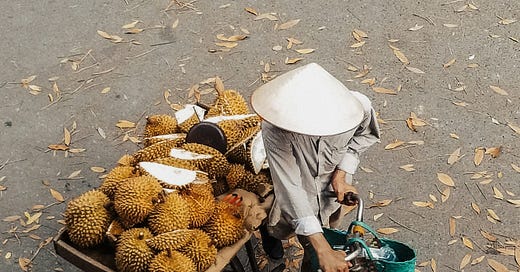I keep coming back to the tension between markets as a way of mediating the informational relationship between what people want and what people have produced and the numerous institutional forms that capitalism piles on to that relationship.
My earliest work on histories of consumerism and commodification forced me to really think deeply about the ways that both desire and need change over time within the consciousness of individuals and within the cultures of communities and societies—at once deeply embedded and yet also sometimes shifting almost overnight. Since the early 19th Century, businesses have spent more and more money and time trying to manage consumer demand, either fixing it in place when they’re in position to satisfy it or moving it when they have something new to sell—or are able to provide it at a new price.
While I was working on my first book, I also ran into a historian, James Livingston, who pushed me to think in new ways about the potentially generative relationship between left critiques of capitalism and liberalism, most particularly in a little-discussed mini-literature about “market socialism”. To simplify somewhat, the basic idea is that market mechanism could, in this body of thought, provide an answer to how to keep a non-capitalist economy adaptive, responsive and efficient to real human needs, as an alternative to a massive, slow-paced and corruption-prone bureaucracy who set production targets far in advance and directly manage the transportation of products to points of distribution.
There’s something elegantly non-human about the basic supply-demand relationship in a well-functioning market system, that doesn’t require a bureaucratic (or corporate) manager. If there’s a strong desire for truffles, but there’s no way to cultivate truffles, then that pushes the price up no matter what an intermediary might decide is “correct” about truffle-eating and truffle-hunting. If the high price drives too many people to hunt for truffles so that they not only extract all the supply but each truffle hunter makes less because of the competition, then some truffle hunters drop out—but it also pushes clever agronomists to see if there’s a way to cultivate truffles successfully, or to push other mushrooms towards a more ‘truffle’ flavor. If the price falls a great deal, maybe it turns out that part of what made the flavor desirable was its rarity and the desire ebbs. Or maybe not, and it turns out people are perfectly happy to shave truffles onto pasta every damn night. That dynamism, barring any intervening institutions, can be extraordinarily rapid in how it affects what populations eat, how they think about the meaning of what they eat, and what people do in terms of labor. That seems really important. I wouldn’t quite call it “freedom” in the conventional sense, but the responsiveness and autonomy of the system in that imaginarily simple sense has a lot of potential to enable human freedom from various kinds of rent-seeking and control.
But of course away from that baby’s-first-market-liberalism level of understanding, it hasn’t worked out that way in either market capitalism or the still-imaginary possibility of ‘market socialism’. In practice, sometimes something like the tragedy of the commons follows, and a commodity that was owned by no one gets stripped so thoroughly from the environment that it never comes back. That’s usually portrayed as a kind of “mob behavior” seen through methodological individualism, but far more often in economic history, there are big organizations facilitating that kind of hyper-exploitation. If not unsustainable harvest, then often the environments and land capable of producing the commodity fall into the hands of large monopolies, who then make moves to subordinate and exploit human labor within that land. (So you go from a region where individuals gathered truffles with their dogs or pigs and received the profits directly from buyers to a world where people get paid a few pennies to gather truffles on land owned by a single organization.) Or alternatively, big companies work together, chasing horizontal integration, in order to reduce the volatility of supply and demand, often becoming something that very nearly resembles the large bureaucracies of 20th Century state socialism, a command institution. That in turn produces incredibly perverse results in terms of overall efficiencies of energy and resource usage as well as human flourishing—commodities produced in one place being shipped tens of thousands of miles away and the same commodity being imported back to that site of production at high price because the people who make or grow the thing also want to buy or consume it themselves.
I was thinking about all this today on reading two New York Times stories, one about the massive increase in durian production spurred primarily by demand in China and the other about the challenges faced by a small Montana business, Old Salt, that is trying to sell beef directly to consumers in Montana rather than to large global corporations.
In both cases, there’s something really powerful and enticing going on. Here is where I think some conventional responses on the left, or among environmentalists, can be lead-footed. Often I think what I would hear as a quick response is “Well, durian should just be a local taste, it should be part of the cultures where durian has a tradition of being grown” or “Well, people should just eat less beef in Montana” or even perhaps “Well, large-scale horizontal integration does lower prices over all to end consumers, so there’s some element of social justice to it.” Those kinds of responses have odd contradictions in them about how we think about locality and globalization, about how we think about wealth and poverty. As the NYT points out, durian farmers are getting rich, and a lot of them are tearing up other cash-crops as much as they are clearing new land. And durian shippers are being incredibly imaginative (and technologically inventive) in solving problems in terms of getting the fruit to end-consumers who are further away (without grossing out passengers in airplanes with its smell). Old Salt, for its part, is doing a wonderful job at getting a great product to people in Montana and keeping them connected to a major part of the state’s economy.
It’s mostly that we know what comes next in the case of durian. Bigger businesses will elbow in on the farmers who are getting rich right now and new kinds of rent-collecting will extract more of the overall wealth being generated in the exchange without adding value to it. What makes durian special will become less special, less connected to regional and local culture. It will get bred more and more for standardization, likely losing flavor and smell in the process. Labor will get squeezed on durian plantations to improve margins for companies, and methods of cultivation will get more and more damaging and extractive.
With Old Salt, sooner or later a big company will come along and buy them out, turn them into a label and a slogan. Or they’ll have to get bigger and in growing they’ll have to bring the price down so they can get on the menu at a BBQ in Havre, Montana, as well as in Helena, and that will push at the integrity of the relationships they’re building with Montana producers. Or maybe it will turn out that the seductive opportunity is providing beef to a high-end restaurant in Jackson Hole. Or Salt Lake City. And that too probably beats a path to being a label rather than a simple model of matching local production to local consumption.
In all these kinds of histories, what happens is that the clarity of signal in a market exchange gets lost, gets captured, gets loaded with noise. What started out as “I am happy to buy a more expensive steak from my neighbor” ends up with “I can’t tell you whether the Sloppy Joe your kid ate at a public school cafeteria in Missoula came from Brazil or Mongolia”; what started as a rush for durians ends with replanting a clear-cut rainforest to produce biofuels because synthetic durian flavor mass-produced in Guangzhou has been added to everything from ice cream to pasta sauce and the value of real durians has crashed, or real durians are being re-routed now exclusively to high-end markets far from where they are grown.
That gets treated as a natural kind of arc in economic development, but it feels less like creative destruction and more like plain destruction. More, it doesn’t feel as if it is coming from what people want or from what people are ready to produce or make, but from some other infrastructure entirely that wants to manage volatility for its own ends, leverage profit to its own interests, and push people at either end of supply and demand out of the way. That, in turn, is why so many people are skeptical if you start trying to explore markets as a basic infrastructure for matching need, desire, labor and production, because in the global economy of the last three centuries, they don’t often seem that way.
Photo by Dave Weatherall on Unsplash
“Meat With Integrity” from https://www.oldsaltco-op.com/.





